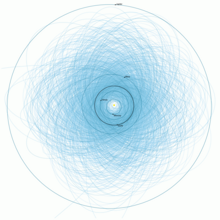User:Sdsds/sandbox/Near-Earth object
Detection and cataloging
[edit]
When a NEO is detected, like all other small Solar System bodies, its positions and brightness are submitted to the (IAU's) Minor Planet Center (MPC) for cataloging. The MPC maintains separate lists of confirmed NEOs and potential NEOs.[1][2] The orbits of some NEOs intersect that of the Earth, so they pose a collision danger.[3] These are considered potentially hazardous objects (PHOs) if their estimated diameter is above 140 meters. The MPC maintains a separate list for the asteroids among PHOs, the potentially hazardous asteroids (PHAs).[4] NEOs are also catalogued by two separate units of the Jet Propulsion Laboratory (JPL) of the National Aeronautics and Space Administration (NASA): the Center for Near Earth Object Studies (CNEOS)[5] and the Solar System Dynamics Group.[6] NEOs are also catalogued by a unit of the European Space Agency (ESA), the Near-Earth Objects Coordination Centre (NEOCC).[7]
Near-Earth objects (NEOs) are formally defined by the International Astronomical Union (IAU) as all small Solar System bodies with orbits around the Sun that are at least partially closer than 1.3 astronomical units (AU; Sun–Earth distance) away from the Sun.[8] This definition excludes larger bodies such as planets, like Venus; natural satellites which orbit bodies other than the Sun, like Earth's Moon; and artificial bodies orbiting the Sun. A small Solar System body can be an asteroid or a comet, thus a NEO is either a near-Earth asteroid (NEA) or a near-Earth comet (NEC). The organisations cataloging NEOs further limit their definition of NEO to objects with an orbital period under 200 years, a restriction that applies to comets in particular,[9][10] but this approach is not universal.[8] Some authors further restrict the definition to orbits that are at least partly further than 0.983 AU away from the Sun.[11][12] NEOs are thus not necessarily currently near the Earth, but they can potentially approach the Earth relatively closely. Many NEOs have complex orbits due to constant perturbation by the Earth's gravity, and some of them can temporarily change from an orbit around the Sun to one around the Earth, but the term is applied flexibly for these objects, too.[13]
PHAs are defined based on two parameters relating to respectively their potential to approach the Earth dangerously closely and the estimated consequences that an impact would have if it occurs.[9] Objects with both an Earth minimum orbit intersection distance (MOID) of 0.05 AU or less and an absolute magnitude of 22.0 or brighter (a rough indicator of large size) are considered PHAs. Objects that either cannot approach closer to the Earth than 0.05 AU (7,500,000 km; 4,600,000 mi), or which are fainter than H = 22.0 (about 140 m (460 ft) in diameter with assumed albedo of 14%), are not considered PHAs.[9]
- ^ "The NEO Confirmation Page". IAU/MPC. Retrieved January 26, 2024.
- ^ Marsden, B. G.; Williams, G. V. (1998). "The NEO Confirmation Page". Planetary and Space Science. 46 (2): 299. Bibcode:1998P&SS...46..299M. doi:10.1016/S0032-0633(96)00153-5.
- ^ Chapman, Clark R. (May 2004). "The hazard of near-Earth asteroid impacts on earth". Earth and Planetary Science Letters. 222 (1): 1–15. Bibcode:2004E&PSL.222....1C. doi:10.1016/j.epsl.2004.03.004.
- ^ "List Of Potentially Hazardous Minor Planets (by designation)". IAU/MPC. Retrieved January 26, 2024.
- ^ Cite error: The named reference
neo-jpl-introwas invoked but never defined (see the help page). - ^ Cite error: The named reference
JPL-SSD-NEAwas invoked but never defined (see the help page). - ^ "About NEOCC". ESA NEOCC. Retrieved January 27, 2024.
- ^ a b Cite error: The named reference
IAU-NEOswas invoked but never defined (see the help page). - ^ a b c "NEO Basics. NEO Groups". NASA/JPL CNEOS. Retrieved January 27, 2024.
- ^ "Definitions & Assumptions". ESA NEOCC. Retrieved January 27, 2024.
- ^ Cite error: The named reference
MorbidelliAstIIIwas invoked but never defined (see the help page). - ^ Waszczak, Adam; Prince, Thomas A.; et al. (2017). "Small Near-Earth Asteroids in the Palomar Transient Factory Survey: A Real-Time Streak-detection System". Publications of the Astronomical Society of the Pacific. 129 (973). part 034402. arXiv:1609.08018. Bibcode:2017PASP..129c4402W. doi:10.1088/1538-3873/129/973/034402. ISSN 1538-3873. S2CID 43606524.
- ^ Cite error: The named reference
ST111230was invoked but never defined (see the help page).
